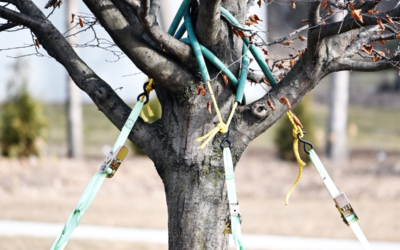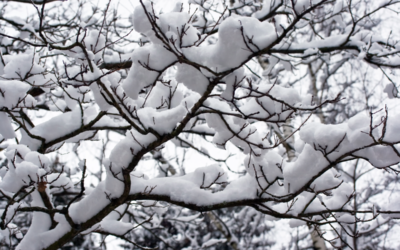Winter brings a new set of concerns for the trees on your property. Cold, snow and ice can damage them, and since they stay active underground, their root systems need protection and nourishment.
Head Off Trouble
Most outdoor winter trouble comes from trees that weren’t properly maintained before the storms set in. Sagging or broken branches due to snow and ice loads are the biggest offenders. They can knock down power lines, wreck roofs and windows, and block roads.
A certified arborist can inspect trees for weaknesses and prune and shape them to withstand the rigors of winter.
Settle in for a Healthy Winter’s Nap
While your trees and shrubs may be dormant above ground, there’s still some activity underground. Even though the root system slows down in winter, it still needs water and nourishment to wake up happy and healthy come spring.
Most established plants have large enough root systems to draw nutrients from the winterizing fertilizer you put on the lawn, but their roots need water all winter long. Give them a good drink before the ground freezes and water them monthly during warm days to supplement snow melt or periods of winter dryness. But be sure to avoid washing deicing chemicals into the soil. They can harm root systems and weaken the plants.
Mulching around the bases of shrubs and tender trees keeps the soil insulated and promotes moisture take-up by the roots. But keep a couple inches of clearance from the trunks to minimize the risk of pest and disease damage. Clean up any fallen leaves and other debris that can serve as hiding places for pests and disease.
Bundle Up Your Babies
Young and delicate trees often lack the thick layer of bark that insulates them against the cold. Besides sub-zero temperatures, our bright, high altitude sun can scorch tender, thin bark. The warm sun activates dormant cells in the bark, then the cells freeze and die when night falls, preventing needed moisture from flowing inside the tree. If not addressed, it can cause the tree’s upper limbs to die and the entire tree becomes more susceptible to disease and harmful insects.
Using a crepe paper tree wrap, start at the base of the tree and wrap upward in an overlapping spiral to a point above the second set of branches. Use an elastic tape to secure the top so it will expand as the tree grows throughout the winter.
When Trouble Strikes
Broken branches and toppled trees present a number of hazards, many of which are beyond the skills of typical homeowners to address safely. You can trim small branches if they aren’t near power lines or threatening to harm buildings, vehicles, or people. But even branches that seem small can weigh a lot and can be unwieldly, so before risking life and limb, literally and figuratively, call a licensed arborist to minimize damage to persons, property, and the tree itself.
Need Help? Call a Pro
If you need help getting your trees and landscaping ready for winter or cleaning up after a storm, don’t hesitate to call in a pro. Donovan Arborists offers planting, pruning, and shearing services as well as a complete landscape maintenance package for property in the Denver area.
We’re always happy to give free estimates to homeowners and property managers for any services they may need.




